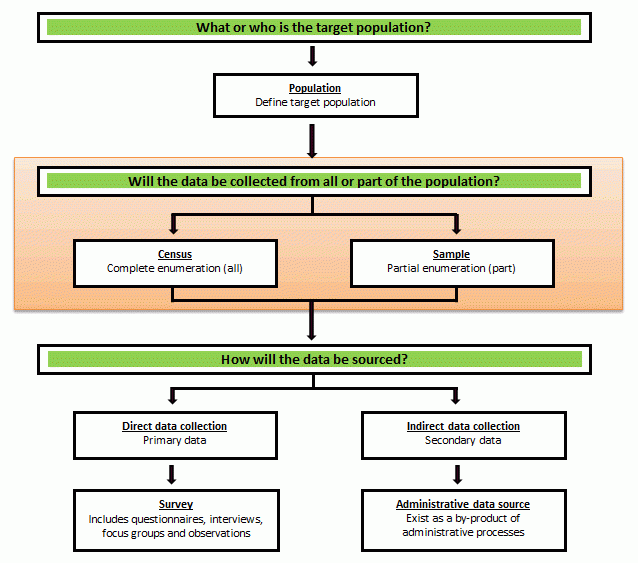Census and sample
Studying a population
A population may be studied using one of two approaches: taking a census, or selecting a sample.
It is important to note that whether a census or a sample is used, both provide information that can be used to draw conclusions about the whole population.
Census: complete enumeration
A census is a study of every unit, everyone or everything, in a population. It is known as a complete enumeration, which means a complete count.
Sample: partial enumeration
A sample is a subset of units in a population, selected to represent all units in a population of interest. It is a partial enumeration because it is a count from part of the population.
Information from the sampled units is used to estimate the characteristics for the entire population of interest.
Choosing between a census or a sample
Once a population has been identified a decision needs to be made about whether taking a census or selecting a sample will be the more suitable option. There are advantages and disadvantages to using a census or sample to study a population:
| Advantages of a census | Disadvantages of a census |
|---|---|
|
|
| Advantages of a sample | Disadvantages of a sample |
|
|
Samples selection
A sample must be robust in its design and large enough to provide a reliable representation of the whole population. Aspects to be considered when designing a sample include the level of accuracy required, cost, and the timing. Sampling can be random or non-random.
Random (or probability) sample
In a random (or probability) sample each unit in the population has a chance of being selected, and this probability can be accurately determined.
Probability or random sampling includes, but is not limited to, simple random sampling, systematic sampling, and stratified sampling. Random sampling makes it possible to produce population estimates from the data obtained from the units included in the sample.
Simple random sample
All members of the sample are chosen at random and have the same chance of being in the sample. A lottery draw is a good example of simple random sampling where the numbers are randomly generated from a defined range of numbers (i.e. 1 through to 45) with each number having an equal chance of being selected.
Systematic random sample
The first member of the sample is chosen at random then the other members of the sample are taken at intervals (i.e. every 4th unit).
Stratified random sample
Relevant subgroups from within the population are identified and random samples are selected from within each strata.
Non-random (or non probability) sample
In a non-random (or non-probability) sample some units of the population have no chance of selection, the selection is non-random, or the probability of their selection can not be determined.
In this method the sampling error cannot be estimated, making it difficult to infer population estimates from the sample. Non-random sampling includes convenience sampling, purposive sampling, quota sampling, and volunteer sampling
Convenience sampling
Units are chosen based on their ease of access;
Purposive sampling
The sample is chosen based on what the researcher thinks is appropriate for the study;
Quota sampling
The researcher can select units as they choose, as long as they reach a defined quota; and
Volunteer sampling
Participants volunteer to be a part of the survey (a common method used for internet based opinion surveys where there is no control over how many or who votes).
Collecting data about a population
Step 2 - Census or sample
Image

Description
Collecting data about a population flowchart
Image
